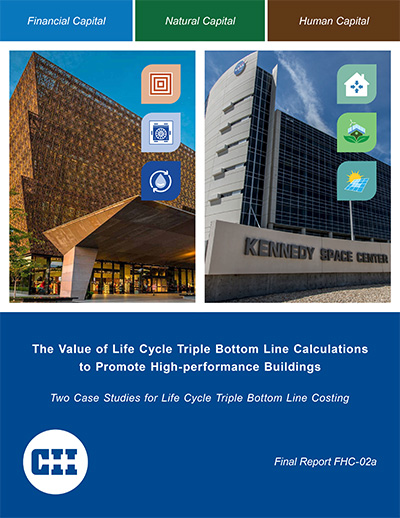
The Value of Life Cycle Triple Bottom Line Calculations to Promote High-performance Buildings
Triple bottom line (TBL) is an accounting framework that captures the financial, environmental, and social impacts of high-performance facility design choices compared to “code minimums” or “business as usual.” The overall objective of the TBL analysis is establishing the life cycle value of project design and engineering alternatives based on financial, environmental, and human capital.
TBL’s life cycle calculations help decision-makers transparently and quantitatively capture the operational, natural, and human capital benefits of high-performance buildings and systems. TBL moves decision-makers away from first-cost comparisons and toward investing in high-performance systems based on commitments to operational, environmental, and social benefits. Incorporating the three “bottom lines” in a life cycle cost (LCC) framework allows investment decisions to be made upon a common platform based upon financial metrics over an agreed project life.
CII’s Facilities and Healthcare Sector Committee challenged Research Team FHC-02 (RT-FHC-02) to identify the barriers to implementing TBL and LCC on facilities, and to calculate the economic benefits of high-performance buildings, including integrating holistic benefits such as occupant health and productivity and the environment. As this report will observe in two case studies, the shift away from basing decisions exclusively on first costs can be especially meaningful for long-term building owners. Natural capital benefits contribute significantly to corporate social responsibility (CSR) and environmental, social, and governance (ESG) reporting and to emerging global goals to address climate change and environmental quality. The TBL LCC calculations presented in the case studies confirm the initial assumption that human capital benefits often overwhelm other cost benefits in the justification of high-performance building design alternatives, because buildings have a major effect on occupant health and productivity as well as organizational effectiveness.
The methodology proposed in this report provides a roadmap and a guide for TBL LCC assessments. The case studies provide strong evidence of the impacts of factors traditionally not included in decision-making and illustrate the application of the methodology.
Triple Bottom Line (TBL) Life Cycle Cost (LCC) calculations help decision-makers transparently and quantitatively capture the operational, natural, and human capital benefits of high-performance buildings and systems. Incorporating the three “bottom lines” in a life cycle cost framework allows investment decisions to be made upon a common platform based upon financial metrics over an agreed project life. TBL LCC moves decision-makers away from first-cost comparisons and toward investing in high-performance systems based on commitments to operational, environmental, and social benefits (FR-FHC-02a, p. 1).
Recommendation: The methodology proposed in Final Report FHC-02a provides a roadmap and a guide for TBL LCC assessments. The case studies provide strong evidence of the impacts of factors traditionally not included in decision-making and illustrate the application of the methodology.
During Phase II, the team observed two case studies and discovered that the shift away from basing decisions exclusively on first costs can be especially meaningful for long-term building owners. Natural capital benefits contribute significantly to corporate social responsibility (CSR) and environmental, social, and governance (ESG) reporting and to emerging global goals to address climate change and environmental quality. The TBL LCC calculations presented in the case studies confirm the initial assumption that human capital benefits often overwhelm other cost benefits in the justification of high-performance building design alternatives, because buildings have a major effect on occupant health and productivity as well as organizational effectiveness (FR-FHC-02a, p. 6).
Recommendation: Use TBL LCC to illuminate the broad scope of benefits of facility investments, especially for long-term building owners and high-performance alternatives.



